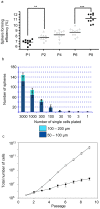Proteomic comparison of mcf-7 tumoursphere and monolayer cultures
- PMID: 23285151
- PMCID: PMC3527578
- DOI: 10.1371/journal.pone.0052692
Proteomic comparison of mcf-7 tumoursphere and monolayer cultures
Abstract
Breast cancer is a heterogeneous disease, composed of tumour cells with differing gene expressions and phenotypes. Very few antigens have been identified and a better understanding of tumour initiating-cells as targets for therapy is critically needed. Recently, a rare subpopulation of cells within tumours has been described with the ability to: (i) initiate and sustain tumour growth; (ii) resist traditional therapies and allow for secondary tumour dissemination; and (iii) display some of the characteristics of stem cells such as self-renewal. These cells are termed tumour-initiating cells or cancer stem cells, or alternatively, in the case of breast cancer, breast cancer stem cells. Previous studies have demonstrated that breast cancer stem cells can be enriched for in "tumoursphere" culture. Proteomics represents a novel way to investigate protein expression between cells. We hypothesise that characterisation of the proteome of the breast cancer line MCF-7 tumourspheres compared to adherent/differentiated cells identifies proteins of novel interest for further isolating or targeting breast cancer stem cells. We present evidence that: (i) the proteome of adherent cells is different to the proteome of cells grown in sphere medium from either early passage (passage 2) or late passage (passage 5) spheres; (ii) that spheres are enriched in expression of a variety of tumour-relevant proteins (including MUC1 and Galectin-3); and (iii) that targeting of one of these identified proteins (galectin-3) using an inhibitor (N-acetyllactosamine) decreases sphere formation/self-renewal of MCF-7 cancer stem cells in vitro and tumourigenicity in vivo. Hence, proteomic analysis of tumourspheres may find use in identifying novel targets for future therapy. The therapeutic targeting of breast cancer stem cells, a highly clinically relevant sub-population of tumour cells, has the potential to eliminate residual disease and may become an important component of a multi-modality treatment of cancer.
Conflict of interest statement
Figures




Similar articles
-
Established breast cancer stem cell markers do not correlate with in vivo tumorigenicity of tumor-initiating cells.Int J Oncol. 2012 Dec;41(6):1932-42. doi: 10.3892/ijo.2012.1654. Epub 2012 Oct 5. Int J Oncol. 2012. PMID: 23042145 Free PMC article.
-
In vitro analysis of breast cancer cell line tumourspheres and primary human breast epithelia mammospheres demonstrates inter- and intrasphere heterogeneity.PLoS One. 2013 Jun 4;8(6):e64388. doi: 10.1371/journal.pone.0064388. Print 2013. PLoS One. 2013. PMID: 23750209 Free PMC article.
-
Binding of galectin-1 to breast cancer cells MCF7 induces apoptosis and inhibition of proliferation in vitro in a 2D- and 3D- cell culture model.BMC Cancer. 2016 Nov 8;16(1):870. doi: 10.1186/s12885-016-2915-8. BMC Cancer. 2016. PMID: 27825375 Free PMC article.
-
Future use of mitocans against tumour-initiating cells?Mol Nutr Food Res. 2009 Jan;53(1):147-53. doi: 10.1002/mnfr.200800254. Mol Nutr Food Res. 2009. PMID: 19123176 Review.
-
Epithelial stem cells and malignancy.J Anat. 2008 Jul;213(1):45-51. doi: 10.1111/j.1469-7580.2008.00895.x. J Anat. 2008. PMID: 18638069 Free PMC article. Review.
Cited by
-
Single-Cell Tracking of Breast Cancer Cells Enables Prediction of Sphere Formation from Early Cell Divisions.iScience. 2018 Oct 26;8:29-39. doi: 10.1016/j.isci.2018.08.015. Epub 2018 Aug 21. iScience. 2018. PMID: 30268511 Free PMC article.
-
Proteomic Analysis Reveals Cadherin, Actin, and Focal Adhesion Molecule-Mediated Formation of Cervical Cancer Spheroids.Cells. 2024 Dec 4;13(23):2004. doi: 10.3390/cells13232004. Cells. 2024. PMID: 39682752 Free PMC article.
-
Chemical composition and the potential for proteomic transformation in cancer, hypoxia, and hyperosmotic stress.PeerJ. 2017 Jun 6;5:e3421. doi: 10.7717/peerj.3421. eCollection 2017. PeerJ. 2017. PMID: 28603672 Free PMC article.
-
Reduction of MHC-I expression limits T-lymphocyte-mediated killing of Cancer-initiating cells.BMC Cancer. 2018 Apr 26;18(1):469. doi: 10.1186/s12885-018-4389-3. BMC Cancer. 2018. PMID: 29699516 Free PMC article.
-
Biological Functions and Identification of Novel Biomarker Expressed on the Surface of Breast Cancer-Derived Cancer Stem Cells via Proteomic Analysis.Mol Cells. 2020 Apr 30;43(4):384-396. doi: 10.14348/molcells.2020.2230. Mol Cells. 2020. PMID: 32235022 Free PMC article.
References
-
- Wicha MS, Liu S, Dontu G (2006) Cancer stem cells: an old idea–a paradigm shift. Cancer Res 66: 1883–1890; discussion 1895–1886. - PubMed
-
- Reynolds BA, Weiss S (1992) Generation of neurons and astrocytes from isolated cells of the adult mammalian central nervous system. Science 255: 1707–1710. - PubMed
-
- Reynolds BA, Weiss S (1996) Clonal and population analyses demonstrate that an EGF-responsive mammalian embryonic CNS precursor is a stem cell. Dev Biol 175: 1–13. - PubMed
Publication types
MeSH terms
Substances
Grants and funding
LinkOut - more resources
Full Text Sources
Medical
Research Materials
Miscellaneous

